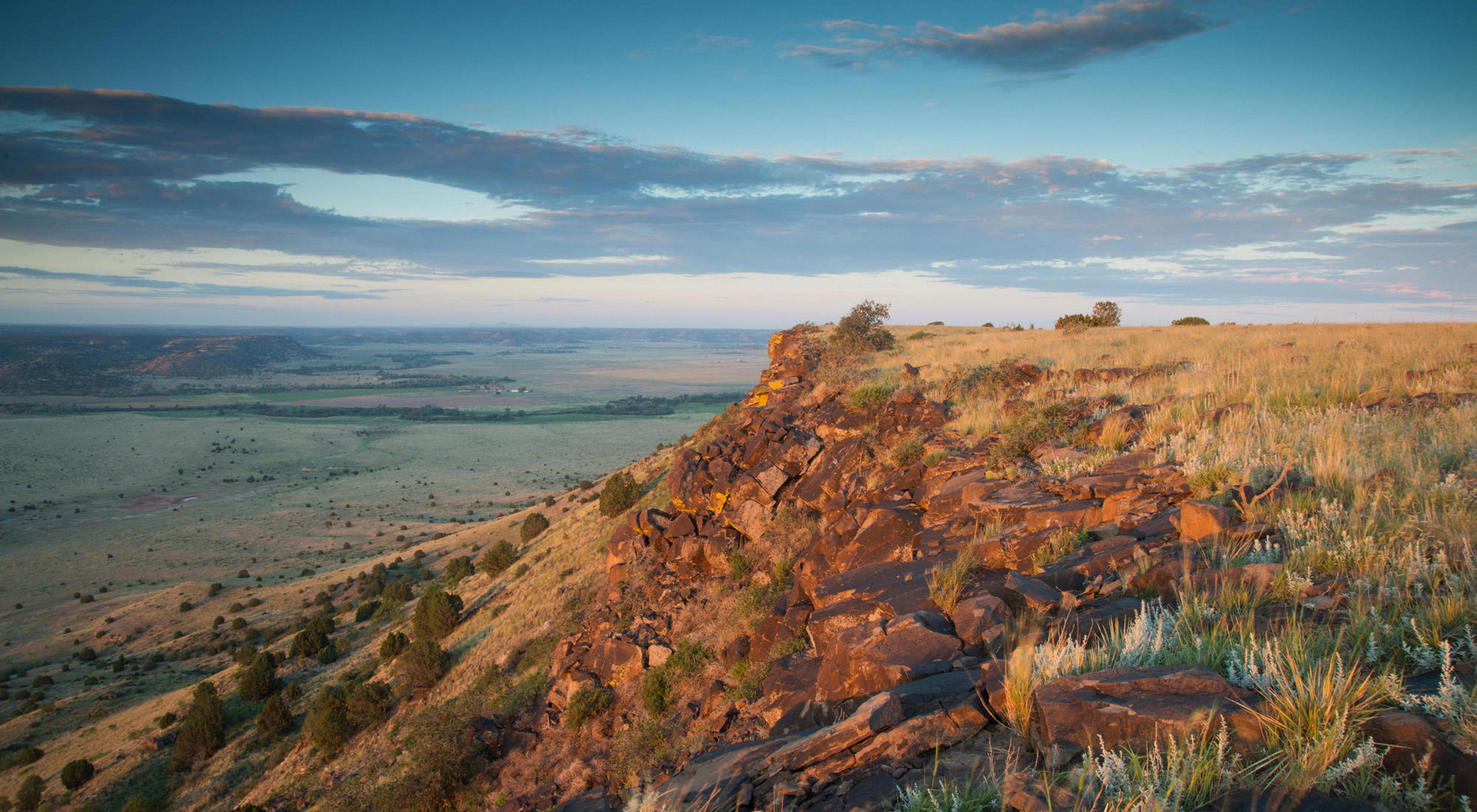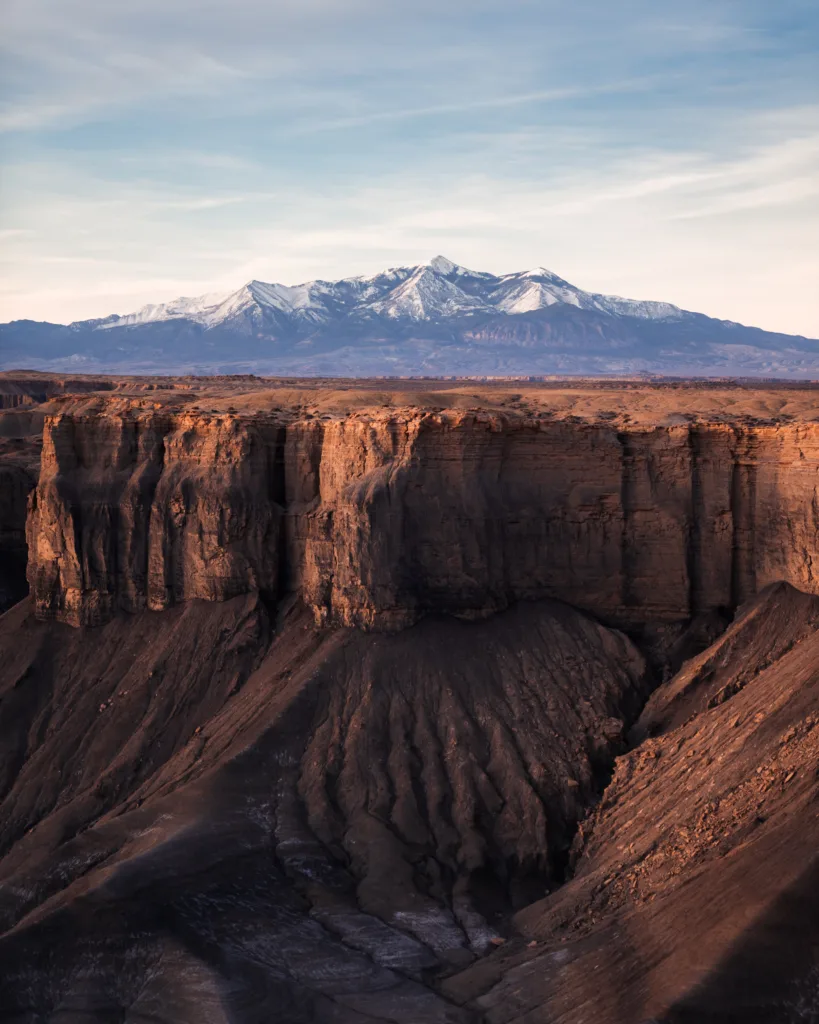Mesas, also known as tablelands, are fascinating geological formations that can be found in various parts of the world. These flat-topped mountains or hills are characterized by their distinct shape, with a wide and flat summit and steep sides. Mesas are created through a process called erosion, specifically when water washes away smaller and softer rocks from the top of a hill, leaving behind a strong and durable caprock.
One of the key features of a mesa is its horizontal rock layers. These formations are often found in dry regions where the rock layers have been deposited in a relatively flat manner. This geological characteristic contributes to the formation of mesas as the erosion process selectively removes the softer rocks, leaving the harder caprock intact.
The size of mesas can vary greatly. In some cases, mesas can stretch for hundreds of kilometers, such as the flat-topped mountains in the Cockburn Range of North Western Australia, which can cover areas up to 350 kilometers. On the other hand, smaller mesas can be as small as 0.1 kilometers in the Elbe Sandstone Mountains of Germany. Despite their size differences, all mesas share the common characteristic of having a flat top and at least one steep side.
Mesas are particularly abundant in the southwestern states of the United States, including Colorado, New Mexico, Utah, and Arizona. These regions, known as the Colorado Plateau, boast a stunning array of mesas that attract visitors from around the world. The unique geological conditions in these areas have resulted in the formation of numerous mesas, each with its own distinct features.
Buttes are often confused with mesas due to their similar appearance. However, there is a subtle difference between the two formations. While mesas have at least one steep side, buttes are smaller and have steep slopes on all sides. In other words, buttes are essentially miniature versions of mesas.
The formation of mesas and buttes is a testament to the power and beauty of erosion. Over millions of years, the forces of nature have sculpted these magnificent formations, creating a striking contrast between the flat table-like tops and the steep, rugged sides.
Mesas are unique geological formations characterized by their flat-topped tablelands and steep sides. These formations are created through the process of erosion, where water washes away softer rocks, leaving behind a durable caprock. Mesas can be found in various dry regions around the world, with the southwestern United States being particularly rich in these formations. Their beauty and distinct shape make them a sight to behold, attracting visitors and geology enthusiasts alike.
How Is Mesa Formed?
A mesa is formed through a natural process known as erosion. Erosion occurs when water, such as rain or flowing rivers, gradually wears away the surface of the land. In the case of a mesa, the erosion process specifically targets smaller and softer types of rocks that make up the top layer of a hill.
The erosion process begins by water running down the slopes of the hill, picking up loose sediment and carrying it away. Over time, this constant flow of water removes the weaker rocks, leaving only the stronger and more durable rock behind. This resilient rock is called caprock and forms the flat, tabletop-like surface of the mesa.
To better comprehend the formation of mesas, it is essential to understand the role of horizontal rock layers and the geographical conditions in which they are found. Mesas are typically found in dry regions where the rock layers are arranged horizontally. This horizontal arrangement allows water to flow easily across the surface, gradually eroding the softer rocks and leaving the resistant caprock intact.
The formation of a mesa involves the erosion of smaller and softer rocks by water, leaving behind a flat-topped structure made of durable caprock. This process occurs in dry regions with horizontally arranged rock layers.

What Is A Mesa?
A mesa, also known as a table, is a type of flat-topped tableland. It is typically found in the Colorado Plateau regions of the United States. Mesas are characterized by their flat surface, which is elevated above the surrounding landscape. They can have one or more steep sides, giving them a distinct appearance.
The term “mesa” is derived from the Spanish word for table, reflecting the table-like shape of these geological formations. They are often formed through the process of erosion, where softer rock layers are eroded away, leaving behind a resistant layer of rock that forms the flat top of the mesa.
Mesas are similar to buttes, which are smaller versions of these table-like formations. The main difference between a mesa and a butte is their size, with mesas being larger in comparison. Both mesas and buttes are common features in areas with sedimentary rock formations, such as the Colorado Plateau.
To summarize, a mesa is a flat-topped tableland with one or more steep sides. It is formed through erosion and can be found in the Colorado Plateau regions of the United States. Mesas are larger than buttes and are characterized by their distinct table-like shape.
What Is An Example Of Mesa?
An example of a mesa can be found in the Cockburn Range of North Western Australia. These mesas are characterized by their flat-topped mountains, which can cover vast areas of up to 350 kilometers (220 miles). These majestic landforms stand out due to their distinctively flat summits.
On the other hand, in the Elbe Sandstone Mountains in Germany, we can find smaller mesas in the form of flat-topped hills. These hills may only cover an area as small as 0.1 kilometers (0.062 miles), but they still exhibit the typical mesa characteristics.
To summarize, the Cockburn Range in Australia and the Elbe Sandstone Mountains in Germany provide contrasting examples of mesas, showcasing the diversity in size and geographical locations where these flat-topped landforms can be found.
Where Can Mesas Be Found?
Mesas can be found primarily in the southwestern states of the United States, specifically in Colorado, New Mexico, Utah, and Arizona. These states are known for their diverse and striking landscapes, which include numerous mesas.
• Colorado: Mesas can be found throughout the state, with notable examples including the Grand Mesa, which is the largest flat-topped mountain in the world, and the Mesa Verde National Park, known for its well-preserved cliff dwellings.
• New Mexico: The state of New Mexico is home to numerous mesas, such as the Taos Plateau and the Zuni-Acoma Trail. In addition, the famous mesas of the Chaco Canyon National Historical Park are a major attraction for visitors.
• Utah: Utah boasts a significant number of mesas, particularly in the southern part of the state. The iconic Monument Valley, with its stunning buttes and mesas, is a popular tourist destination. Other notable mesas in Utah include the Cedar Mesa, the San Rafael Swell, and the Manti-La Sal National Forest.
• Arizona: Mesas are abundant in Arizona, with the most famous example being the Monument Valley Navajo Tribal Park, which straddles the Arizona-Utah border. The Vermilion Cliffs National Monument and the Petrified Forest National Park are also known for their mesas.
Mesas can be found in these four southwestern states, showcasing the unique and beautiful landscapes that make this region so special.

Conclusion
Mesas are flat-topped tablelands with one or more steep sides. They are formed through the erosion process, where water washes away smaller and softer rocks from the top of a hill, leaving behind a strong and durable rock called caprock. Mesas are typically wider than they are tall and are commonly found in dry regions with horizontal rock layers, such as the Colorado Plateau regions of the United States. These isolated, broad flat-topped mountains have at least one steep side, distinguishing them from buttes, which are smaller flat-topped mountains or hills with steep slopes on all sides. Mesas are particularly abundant in the southwestern states of Colorado, New Mexico, Utah, and Arizona.
